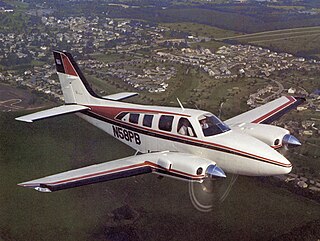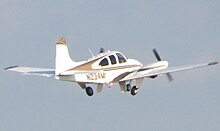Beechcraft is a brand of Textron Aviation since 2014. Originally, it was a brand of Beech Aircraft Corporation, an American manufacturer of general aviation, commercial, and military aircraft, ranging from light single-engined aircraft to twin-engined turboprop transports, business jets, and military trainers. Beech later became a division of Raytheon and then Hawker Beechcraft before a bankruptcy sale turned its assets over to Textron. It remains a brand of Textron Aviation.

The Piper PA-23, named Apache and later Aztec, is a four- to six-seat twin-engined light aircraft aimed at the general-aviation market. The United States Navy and military forces in other countries also used it in small numbers. Originally designed in the 1950s by the Stinson Aircraft Company, Piper Aircraft manufactured the Apache and a more powerful version, the Aztec, in the United States from the 1950s to the 1980s.

The Cessna 152 is an American two-seat, fixed-tricycle-gear, general aviation airplane, used primarily for flight training and personal use. It was based on the earlier Cessna 150 incorporating a number of minor design changes and a slightly more powerful engine with a longer time between overhaul.

The Beechcraft Baron is a light twin-engined piston aircraft designed and produced by Beechcraft. The aircraft was introduced in 1961. A low-wing monoplane developed from the Travel Air, it remains in production.

The Beechcraft Model 50 Twin Bonanza is a small twin-engined aircraft designed by Beechcraft as an executive transport for the business market. It was developed to fill a gap in Beechcraft's product line between the single-engined Model 35 Bonanza and the larger Model 18. The Twin Bonanza is dissimilar to the Bonanza, being much larger and heavier and using more powerful engines, while in its earliest form having only half the passenger capacity of the Model 18.

The Beechcraft Model 17 Staggerwing is an American biplane with an atypical negative wing stagger. It first flew in 1932.

The Rutan Model 202 Boomerang is an aircraft designed and built by Burt Rutan. The design was intended to be a multi-engine aircraft that in the event of failure of a single engine would not become dangerously difficult to control due to asymmetric thrust. The result is an asymmetrical aircraft with a very distinct appearance.

The Beechcraft Model 76 Duchess is an American twin-engined monoplane built by Beechcraft intended partly as a low cost introduction to twin-engine aircraft.

The Beechcraft Musketeer is a family of single-engined, low-wing, light aircraft that was produced by Beechcraft. The line includes the Model 19 Musketeer Sport, the Model 23 Musketeer, Custom and Sundowner, the Model 23-24 Musketeer Super III the retractable gear Model 24-R Sierra and the military CT-134 Musketeer.

The Cessna T303 Crusader is an American six-place light twin-engined aircraft built by Cessna Aircraft Company. Production ceased in 1986.

The Beechcraft Model 77 Skipper is a two-seat, fixed tricycle gear general aviation airplane, originally designed for flight training but also used for touring and personal flying.

The Cessna 177 Cardinal is a light single-engine, high-wing general aviation aircraft produced by Cessna. It was intended to replace the Cessna 172 Skyhawk. First announced in 1967, it was produced from 1968 to 1978.

The Beechcraft 60 Duke is an American-built twin-engine fixed-wing aircraft created by Beechcraft. The aircraft has retractable tricycle landing gear and a pressurized cabin. The two piston engines are turbocharged and the turbochargers also pressurize the cabin with bleed air.

The Cessna 310 is an American four-to-six-seat, low-wing, twin-engine monoplane produced by Cessna between 1954 and 1980. It was the first twin-engine aircraft that Cessna put into production after World War II.

The Beechcraft Queen Air is a twin-engined light aircraft produced by Beechcraft in several versions from 1960 to 1978. Based upon the Twin Bonanza, with which it shared key components such as wings, engines, and tail surfaces, but featuring a larger fuselage, it served as the basis for the highly successful King Air series of turboprop aircraft. It is often used as a private aircraft, a utility, or a small commuter airliner. Production ran for 17 years.

The Bellanca Viking and Super Viking are a series of single-engine, four-seat, high performance, retractable gear aircraft manufactured in the USA during the 1960s and 1970s. The aircraft developed through modifications of classic designs by the aviation pioneer Giuseppe Bellanca. A total of 1,356 Vikings have been produced with most production between 1968 and 1975.

The Beechcraft CT-134 Musketeer is a military training derivative of the Musketeer built by Beechcraft for the Canadian Armed Forces. The CT-134 was a single engine, low-wing, four-seat light aircraft with fixed landing gear and a limited aerobatic capability.

The Scaled Composites Model 81 Catbird is a high-efficiency five-seat single-engine all-composite general aviation aircraft designed by Burt Rutan. It is unusual in that it incorporates both a small forward wing and a small conventional horizontal stabilizer on the tail.

The Wickham B is an American experimental twin engined, homebuilt aircraft.
The Beechcraft Heritage Museum is an aviation museum at the Tullahoma Regional Airport in Tullahoma, Tennessee. It is focused on the history of the Beech Aircraft Corporation.




















